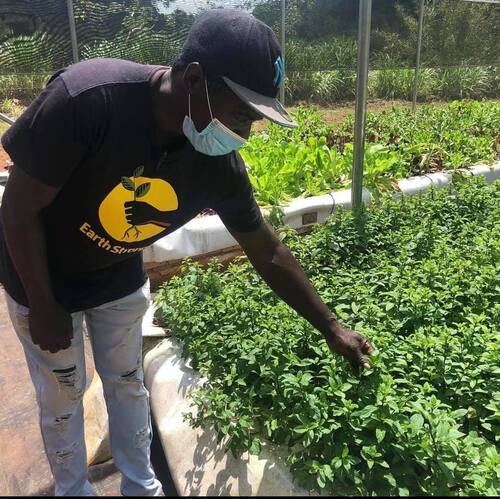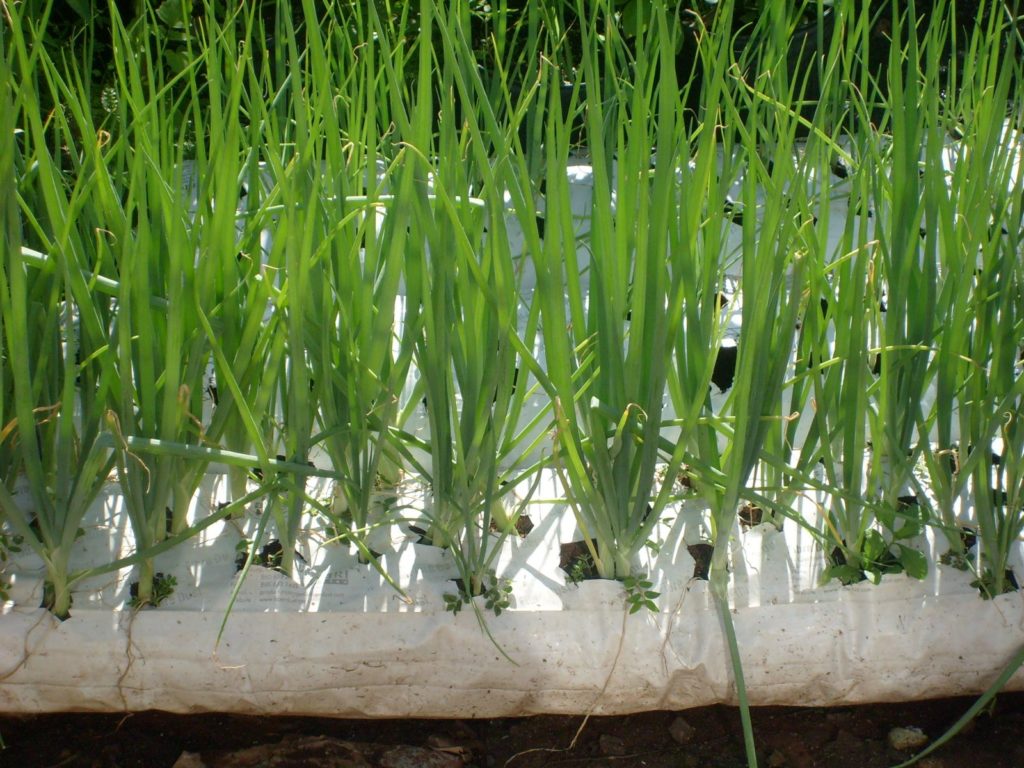
Constructed in 2004 with a grant of J$1.7 million from the G. Raymond Chang Foundation, the JBI Plant Nursery has been described as one of the JBI’s best kept secrets. The facility is strategically located on the JBI compound in Hope Gardens and has the capacity to produce an average of 1.2 million seedlings annually.
The Nursery specializes in the production of high quality vegetable and herb seedlings and an assortment of fruit tree plants. These include Scotch Bonnet Pepper, West Indies Red Pepper, Sweet Pepper, Tomato, Pak Choi, Lettuce, Cabbage, Callaloo, Broccoli, Cauliflower, Onion, Escallion, Thyme, Parsley, Basil, Celery, Oregano, Fennel, June Plum, Mango and Pear.
Constructed in 2004 with a grant of J$1.7 million from the G. Raymond Chang Foundation, the JBI Plant Nursery has been described as one of the JBI’s best kept secrets. The facility is strategically located on the JBI compound in Hope Gardens and has the capacity to produce an average of 1.2 million seedlings annually.
The Nursery specializes in the production of high quality vegetable and herb seedlings and an assortment of fruit tree plants. These include Scotch Bonnet Pepper, West Indies Red Pepper, Sweet Pepper, Tomato, Pak Choi, Lettuce, Cabbage, Callaloo, Broccoli, Cauliflower, Onion, Escallion, Thyme, Parsley, Basil, Celery, Oregano, Fennel, June Plum, Mango and Pear.
Create Your Own Garden
Check-out our product listing loaded with all kinds of plants for your home garden and more.
How To Establish A Home Garden

The space required depends upon the growth pattern of the vegetable, the fertility of the garden, the desired size of the produce and the size of the garden. Small vegetables (lettuce, pak choi, cabbage) should be spaced six inches apart in the row, larger vegetables (tomato, sweet pepper, hot pepper), 15 to 24 inches apart and trellised. If larger fruits are desired at harvest, vegetables should be planted 24 to 36 inches apart. Some varieties may need 4 feet between plants and 5 to 6 feet between rows to allow comfortable harvest room.
Buying high quality disease free seedlings from the Jamaica Bauxite Institute Nursery is the best way to start your home garden as it saves several weeks in growing time.
Apply starter fertilizer (11:22:22, 20:20:20 or 15:5:35) when transplanting. Cultivate shallowly to keep down weeds without damaging roots. Mulching with organic matter is recommended but black plastic is also suitable for mulching. Generous application of organic materials (Rescue, compost, manure) is encouraged to improve the soil conditions, retain moisture and provide nutrients (N, P and S).
Water the plants thoroughly and regularly during dry periods. Don’t let your garden dry out before it even hits full stride. Get into the rhythm of watering regularly early in the morning to ensure happy, healthy plants. Do not over water.
Regular inspection should be done to identify insects, pests and diseases. Manual removal of insects and pests are strongly suggested. If not possible, one tablespoon of Malathion or Actara per gallon of water can be used effectively to control insects and pests. Champion or Amistar can be used to control fungus.
Plants confined in home garden may need daily or even more frequent watering. Side-dress nitrogen fertilizer (20:20:20) equivalent to one tablespoon per plant after the first week. Trellises or cages are used to train vegetables (tomato, cucumber, sweet pepper) with great success but mulching will produce similar effect.
Vegetables should be harvested when fit or as the gardener desires them. Vegetables and fruits are of highest quality when they are reaped fresh daily. Tomatoes and sweet pepper can be picked every day or two. Harvest the fruits when color has started to develop and ripen them further indoors.
How To Establish A Home Garden
The space required depends upon the growth pattern of the vegetable, the fertility of the garden, the desired size of the produce and the size of the garden. Small vegetables (lettuce, pak choi, cabbage) should be spaced six inches apart in the row, larger vegetables (tomato, sweet pepper, hot pepper), 15 to 24 inches apart and trellised. If larger fruits are desired at harvest, vegetables should be planted 24 to 36 inches apart. Some varieties may need 4 feet between plants and 5 to 6 feet between rows to allow comfortable harvest room.
Buying high quality disease free seedlings from the Jamaica Bauxite Institute Nursery is the best way to start your home garden as it saves several weeks in growing time.
Apply starter fertilizer (11:22:22, 20:20:20 or 15:5:35) when transplanting. Cultivate shallowly to keep down weeds without damaging roots. Mulching with organic matter is recommended but black plastic is also suitable for mulching. Generous application of organic materials (Rescue, compost, manure) is encouraged to improve the soil conditions, retain moisture and provide nutrients (N, P and S).
Water the plants thoroughly and regularly during dry periods. Don’t let your garden dry out before it even hits full stride. Get into the rhythm of watering regularly early in the morning to ensure happy, healthy plants. Do not over water.
Regular inspection should be done to identify insects, pests and diseases. Manual removal of insects and pests are strongly suggested. If not possible, one tablespoon of Malathion or Actara per gallon of water can be used effectively to control insects and pests. Champion or Amistar can be used to control fungus.
Plants confined in home garden may need daily or even more frequent watering. Side-dress nitrogen fertilizer (20:20:20) equivalent to one tablespoon per plant after the first week. Trellises or cages are used to train vegetables (tomato, cucumber, sweet pepper) with great success but mulching will produce similar effect.
Vegetables should be harvested when fit or as the gardener desires them. Vegetables and fruits are of highest quality when they are reaped fresh daily. Tomatoes and sweet pepper can be picked every day or two. Harvest the fruits when color has started to develop and ripen them further indoors.
Creating your own Grow Bag Garden

Because more people now live where traditional vegetable gardening is not possible, container and patio gardens have become more popular. Their ornamental value is an added benefit and their fruit quality has recently been improved as well.
Acquire your Grow Bag from the Jamaica Bauxite Institute Nursery planted with assorted vegetables and fruits or with one variety of vegetable or fruit . Pre order your customized grow bag.
- Make a small slit about one (1) inch at one end at the top.
- Completely hydrate the bag to full volume.
- Purchase seedlings from JBI.
- Determine the spacing based on size of fruit or vegetable you want to harvest, level of fertility you will be able to maintain and type (variety) of vegetables or fruits you intend to grow.
- Water every day or as required.
- Fertilize with 20-20-20 (complete fertilizer), one (1) tablespoon per gallon of water twice per week or as required. Fertilize with Calcium Nitrate (1 tsp per gallon of water) and Magnesium Sulphate (1 tsp per gallon of water) at weeks two and four.
Creating your own Grow Bag Garden
Because more people now live where traditional vegetable gardening is not possible, container and patio gardens have become more popular. Their ornamental value is an added benefit and their fruit quality has recently been improved as well.
Acquire your Grow Bag from the Jamaica Bauxite Institute Nursery planted with assorted vegetables and fruits or with one variety of vegetable or fruit . Pre order your customized grow bag.
- Make a small slit about one (1) inch at one end at the top.
- Completely hydrate the bag to full volume.
- Purchase seedlings from JBI.
- Determine the spacing based on size of fruit or vegetable you want to harvest, level of fertility you will be able to maintain and type (variety) of vegetables or fruits you intend to grow.
- Water every day or as required.
- Fertilize with 20-20-20 (complete fertilizer), one (1) tablespoon per gallon of water twice per week or as required. Fertilize with Calcium Nitrate (1 tsp per gallon of water) and Magnesium Sulphate (1 tsp per gallon of water) at weeks two and four.




